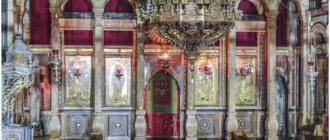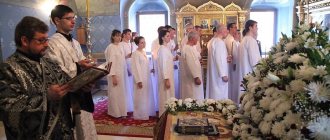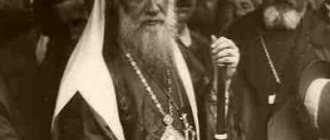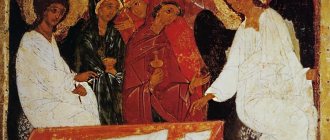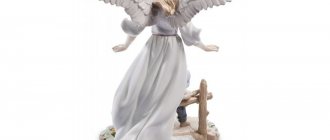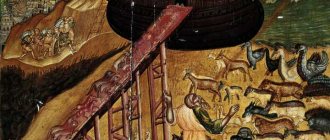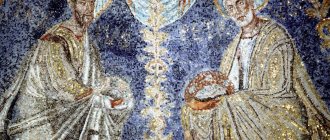Saints Constantine and Helen
Estimated reading time: less than a minute.
June 3 is the day of remembrance of the saints Tsar Constantine and his mother Queen Helena. In the Orthodox Church, the great mother and son are glorified as equal to the apostles - their feat of preaching the Gospel and converting peoples to the faith is so significant. Constantine was born in the Serbian city of Nis, in 272. Elena - in Drepan (Asia Minor), later renamed Elenopolis in honor of her. The year of birth of Elena herself is not precisely established...
Ambrose of Milan wrote that Helen was the daughter of an innkeeper and met the future emperor Constantius Chlorus, Constantine's father, when he, still a young officer, was riding horses, and she served him wine.
When Constantine was 21, his father divorced Helena in order to marry the daughter of Emperor Maximian and strengthen his position at court. He became Caesar of the province of Gallia Belgica. In 306, after his death, Constantine was proclaimed emperor of this province.
In 312, Constantine entered into a power struggle with the usurper Maxentius. On the eve of the decisive battle, he had a dream: he needed to draw an image of the Christian cross on the banners, and then he would win (“and thus win”). And so it happened. Constantine became emperor of the western part of the Roman Empire. He succeeded in completely unifying the lands in 321.
In 313 in Milan, at the wedding of his sister, Constantine, who believed in Christ, announced an edict that legalized Christianity on the territory of the Roman Empire. Emperor Diocletian, an ardent persecutor of Christians, was also invited to the feast as an honorary guest. However, he did not come.
Elena, while in Trier, gave part of her house to the Christian community of the city so that a church could be built there. It became one of the oldest official churches, along with the Church of the Holy Sepulcher and the Church of the Nativity in Bethlehem. Constantine gave his mother the title of empress. The first coins found with her image date back to 318.
Saint Helena became a Christian at the age of 60. In 326, she made a pilgrimage to Jerusalem, where she undertook archaeological research, discovering the Cross of the Lord, nails and a tablet with the inscription “Jesus of Nazareth, King of the Jews.” At the time of this trip she was about 80 years old.
In 325, Constantine convened the First Ecumenical Council, where the Creed of Christians was formulated. At this council, the emperor personally greeted the confessors of the faith who suffered during the years of persecution, kissing their wounds. In 320, he moved the capital of the Roman Empire to a new city - Constantinople, which later became the center of the Eastern Empire - Byzantium.
Constantine dreamed all his life of being baptized in the Jordan, but was baptized shortly before his death at his residence near Constantinople. He died in 337. The exact date of Elena's death is unknown
We thank Timofey Katnis for his help in preparing the material. Drawings by Elena Popovskaya
Description of the holy image
Lifetime images of the queen have survived to this day, this is her sculpture, as well as a profile image on coins. Of course, in these images Elena is somewhat idealized, but in general her external features are most likely conveyed accurately. The veneration of the saint began immediately after her death and several centuries later, the first icon of St. Helena appeared. Over time, a certain tradition developed on how to depict the saint on icons.
- It is not so often among ancient icons that the image of Helen alone is found; as a rule, she is together with her son, who stands on the left side of her, and between them is the Cross of the Lord. This is a classic image of a queen.
Icon of Saints Equal to the Apostles Constantine and Helen - An icon with hagiographical marks, small miniatures, where there are sketches of the main events in the life of the saint: the vision, the journey to Jerusalem, the finding of the Cross of the Lord.
- The icon of Equal-to-the-Apostles Helen, where she is alone without her son, often represents the queen with a dish on which lie four nails that she found during excavations.
It is characteristic that in all iconographic images, St. Elena appears as a young, pretty woman. Despite the fact that she had already come to faith at an old age and died when she was already over 80 years old. And this is not accidental, because through this the icon painters tried to emphasize the spiritual youth of St. Elena.
Empress Helena
Years passed, and Constantius Chlorus, Helen’s ex-husband, died. At the end of his life, he was the ruler of the Western lands of the Roman Empire, appointed to this post by Diocletian, who once elevated him at the cost of family happiness. After the death of his father, Helen's son Constantine took his place, posing serious competition to the emperor Maximian who ruled in those years. Their political confrontation resulted in an open war, in which Constantine won and became the sole ruler of the Great Roman Empire.
One of his first acts of state was an edict, as a result of which Christianity received legal status. This document ended almost three centuries of Roman persecution of the church. Having become emperor, Constantine summoned his mother to the capital and elevated her to the rank of Augusta, that is, empress and his co-ruler.
How does St. help? Elena
People turn to the image of the saint for:
- help in important matters;
- with a request for career growth;
- solving issues of material well-being;
- about maintaining peace and prosperity in the family;
- assistance in childbirth;
- in raising children;
- about increasing yields.
People whose profession is connected with the highest government positions should seek prayerful help from Queen Helena and her son, Emperor Constantine.
Queen Helena is the patroness of missionaries and philanthropists, all of whom selflessly serve to spread and preserve the faith of Christ.
On the path of serving God
However, a wise and devoid of vanity woman, knowing how transitory earthly glory can be, used the opportunities that opened up to her not for personal benefit, but for serving the church. By her order and at her expense, Christian churches were built and new communities were created in the empire, which had not yet awakened from its pagan sleep. But ahead lay the main mission that Saint Helena had to fulfill.
The icon, the meaning of which is expressed by the plot composition itself, presents the viewer with the Equal-to-the-Apostles Empress next to the Cross of the Lord she acquired. It is in this find, which has become the greatest shrine of the entire Orthodox world, that its historical merit lies.
Meaning of the icon
Modern icon painters most often depict the holy queen unaccompanied by her royal son, but invariably holding a cross in her right hand.
Queen Helen Equal to the Apostles
The significance of the icon of St. Helena is enormous in its visual impact on a person:
- an iconographic plot where Elena, together with her son, symbolizes the inviolability of family values and filial love for the mother;
- the cross in the hands of a saint means devotion to the true faith and readiness to suffer for Christ.
Important!
In the Christian world, the saint has always been revered and enjoyed great respect. It is no coincidence that Equal-to-the-Apostles Olga took the name Elena in baptism, and two more saints who bear the name of her royal successor were glorified - Elena of Serbia and Elena of Diveevskaya.
Story
Cyril and Methodius are famous for their preaching of Christianity in Great Moravia, which in the 9th century included modern Czech Republic, Slovakia and Austria.
Ruler Rostislav (later Saint Rostislav), seeking to avoid the influence of the Franco-German Carolingians, turned to Rome for missionaries for Moravia, but Rome refused. Therefore, Rostislav turned instead to the Byzantine Empire, which resulted in the sending of Cyril and Methodius.
With the approval of the Pope, they taught in the Slavic language rather than Latin, which caused considerable friction among the German monks and clergy, who tried to stop preaching and writing in the Slavic language, but without success.
From this it can be seen that at that time religion and politics were very mixed. Moreover, although the two branches of Christianity, Greek and Roman, had not yet split in the Great Schism of 1054, there were nevertheless already signs of discord, to which political interests were added.
The preaching of Cyril and Methodius added a third element to this - Slavic Christianity, which eventually led to the Russian concept of Moscow as the "Third Rome" after the fall of the Byzantine Empire in 1453. After this, Greek Orthodoxy declined as Russian Orthodoxy continued its rise.
In any case, Cyril and Methodius, being saints before the schism, are now highly revered both in Eastern Orthodoxy (especially in its Russian form) and in Roman Catholic Christianity.
Prayer 1
About the wonderful and all-praised king, the holy Equal-to-the-Apostles Constantine and Helen!
To you, as a warm intercessor, we offer our unworthy prayers, for you have great boldness towards the Lord.
Ask Him for the peace of the Church and prosperity for the whole world, wisdom for the ruler, care for the flock for the shepherd, humility for the flock, desired peace for the elders, strength for husbands, beauty for women, purity for virgins, obedience for children, Christian education for babies, healing for the sick, reconciliation for those at war, patience for the offended, those who offend the fear of God.
To those who come to this temple and pray in it, a holy blessing and everything useful for each request, let us praise and sing the Benefactor of all God in the Trinity of the glorified Father, and the Son, and the Holy Spirit, now and ever and unto ages of ages. Amen.
Magazine about stars and astrology
every day fresh articles about astrology and esotericism
Icon of the Mother of God “Helper of Sinners”
The icon “Helper of Sinners” is deeply revered by Orthodox Christians. This is one of the most amazing icons, whose spiritual meaning.
Icon "Protection of the Blessed Virgin Mary"
The “Protection of the Mother of God” icon is one of the most significant shrines among all Orthodox images. This icon symbolizes.
Vladimir Icon of the Mother of God
The image of the Mother of God is especially revered by all Orthodox Christians. The Vladimir icon is notable for its special power: prayers before it.
Kazan Icon of the Mother of God
The Kazan Icon of the Mother of God is widely known among Orthodox Christians. The intercessor and protector of all people is found in almost every home.
Icon of the Mother of God “Softening Evil Hearts”
The icon “Softening Evil Hearts” is one of the most revered in the Orthodox world. Her veneration is associated with miraculous powers capable of healing.
The innkeeper's young daughter
Who is she, Holy Equal-to-the-Apostles Queen Helen, whose icon is found in most Russian churches and attracts crowds of believers? To answer this question, let us open the life of the holy servant of God, compiled a short time after her blessed death, and the few works of ancient historians that have reached us, describing her glorious deeds.
Around 250, in the Asia Minor city of Bethany, the owner of a local inn had a daughter who helped him serve visitors. This was the future Saint Helen. The icon of this queen equal to the apostles presents us today with the image of a majestic woman, directing her inner gaze to the heavenly world, and in those days she was still a simple girl who did not think about the great mission ahead of her. And, as happened at all times, one day she fell in love.
